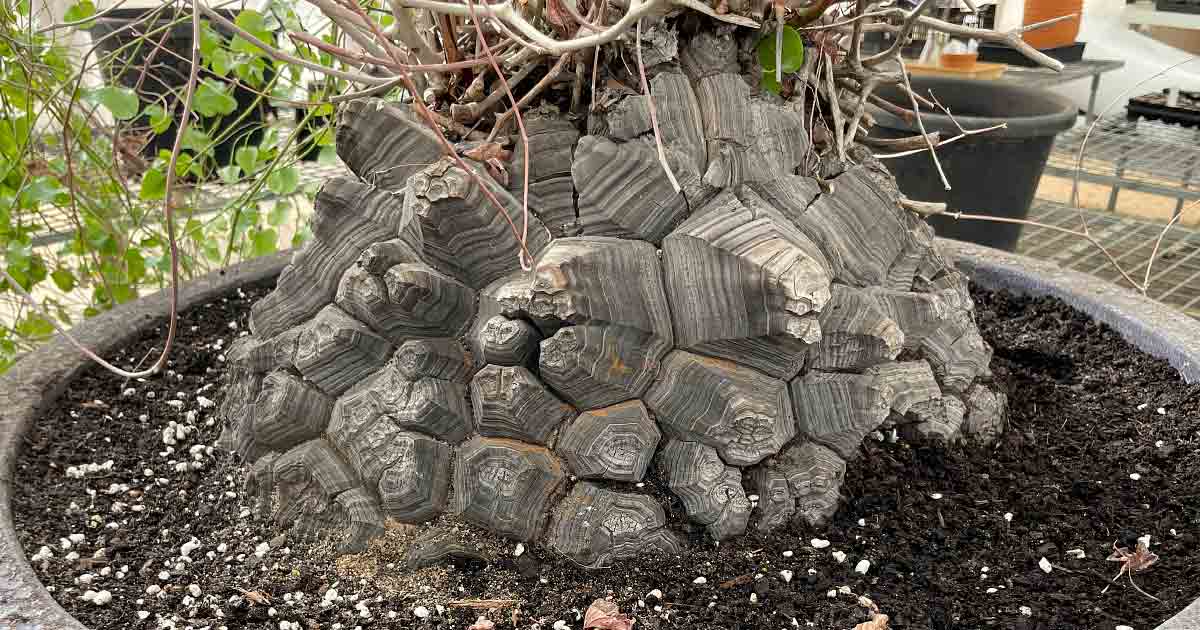Dioscorea elephantipes is a perennial climbing or scrambling plant commonly call the ‘Elephant’s Foot Plant ‘.

It is long lived and over time forms a large woody caudex or tuber above the ground. It is grown as much for the large woody caudex as it is for the foliage.
From South Africa it also has a few common names, Elephants foot plant, Tortoise Shell Dragon Plant (龟甲龙) and Hottentot bread are a few.
This is a slow growing succulent that grows in winter and spring in its natural environment, it is dormant in summer and need very little water over this period.

Foliage dies back during summer dormancy with only the large woody caudex being visible.
In winter the new growth commences with heart shaped leaves appearing on long vines or stems.
Growth rate is reasonably slow however a large caudex to around 15 cm can be achieved in 5 – 7 years in good conditions.
Being summer deciduous this is a drought tolerant plant that actually requires a dry summer. The growth period is from late summer through winter into spring.
How to Grow and Care For Dioscorea elephantipes
This is a plant that requires a hot dry summer to grow well it also needs protection from frosts and freezes.
Drainage and watering are the key to growing this amazing succulent successfully.
- Plant in a container using a specialist cactus and succulent potting mix with 20 – 20 pumice mixed through to ensure good drainage.
- Allowed the soil to dry between waterings and it is the soil around the woody caudex that is watered, not the caudex itself.
- Fertilise during active growth periods with a 25% strength solution of a liquid fertiliser, seaweed and fish emulsion is ideal.
- As the old foliage dies back you can prune it right down to the caudex itself.
- Provide support the long stems that appear from the caudex in late summer.
Repotting
As the caudex gets larger you will need to repot. Make sure that you use a pot that is just a little larger than the caudex itself, around 1/3 the diameter of the caudex larger is ideal.
Dioscorea elephantipes Propagation
Usually from seed which are sown into seed trays and covered with a free draining potting mix. As Dioscorea elephantipes are dioecious you need both male and female plants for seed.

Plant seeds at around 2.5 cm deep and water in once.
Top Tips for Growing Your Elephant’s Foot Plant
- The best soil is a well drained open soil. In containers consider adding good amounts of gravel, pumice or perlite.
- The root system grows around the edge of the caudex with the centre being almost hollow. A top dressing with gravel or Akadama can help protect the root system.
- Temperature range is best above 18C 64F in the daytime for optimal growth.
Summary Information
- Botanical Name – Dioscorea elephantipes
- Common Name – Elephant’s Foot Plant, Hottentot bread, Tortoise Shell Dragon Plant.
- Family – Dioscorea
- Origins – Southern Africa
- Height – The vine will climb to around 1 metre in height.
- Spread – The woody caudex will reach around 45 cm across over time
- Growth rate – Slow.
- Position – Full sun.
- Soil – Free draining
- Flowers – Small yellow to pink.
- Flowering Time – Late summer
- Foliage – Mid to deep green.
- Frost tolerant – Yes
- Drought tolerant – Yes
